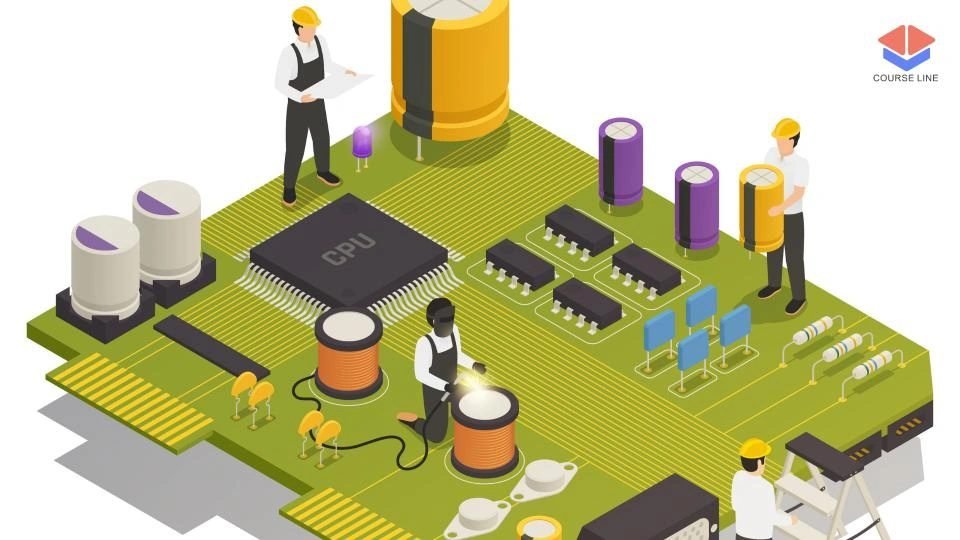Course Features
Price
Study Method
Online | Self-paced
Course Format
Reading Material - PDF, article
Duration
3 hours, 25 minutes
Qualification
No formal qualification
Certificate
At completion
Additional info
Coming soon
- Share
Overview
The Microelectronic Engineering Level 3 Advanced Diploma is designed to introduce learners to the fast-evolving world of miniaturized electronic systems that power modern technologies. From mobile devices to medical instruments, microelectronics are at the core of innovation in today’s digital world. This course offers a detailed overview of key concepts in microelectronic design, semiconductor physics, digital and analog circuitry, and printed circuit board (PCB) fabrication.
The course begins with an introduction to microelectronic engineering, where students become familiar with the language, components, and principles used in this field. Core lessons explore the physics behind semiconductors, including how materials are doped and how components such as diodes, transistors, and integrated circuits function at the microscopic level. These concepts are essential for understanding how modern electronic devices are developed and optimized.
As the course progresses, students will delve into electronic circuit theory. They will learn about passive components such as resistors and capacitors, as well as active components like transistors and operational amplifiers. The programme also explores digital electronics, with a focus on logic gates, Boolean algebra, and circuit design, enabling learners to create and troubleshoot basic digital systems.
A dedicated module on microcontroller systems introduces students to embedded programming and hardware integration. Through hands-on exercises, learners gain experience in programming microcontrollers for real-world applications such as automation and sensor systems. This is a crucial skill set for anyone interested in the Internet of Things (IoT), robotics, or consumer electronics.
The course also covers PCB design and fabrication, equipping learners with the knowledge to layout electronic components and fabricate circuit boards using industry-standard tools. These practical skills are essential for prototyping and testing custom hardware.
To ensure students are prepared for emerging trends, the final module introduces advanced topics such as the distinctions between analog and digital systems, as well as cutting-edge technologies shaping the future of electronics. Whether learners pursue employment or further study, this course builds a strong technical foundation for long-term success.
Who is this course for?
The Microelectronic Engineering Level 3 Advanced Diploma is designed to introduce learners to the fast-evolving world of miniaturized electronic systems that power modern technologies. From mobile devices to medical instruments, microelectronics are at the core of innovation in today’s digital world. This course offers a detailed overview of key concepts in microelectronic design, semiconductor physics, digital and analog circuitry, and printed circuit board (PCB) fabrication.
The course begins with an introduction to microelectronic engineering, where students become familiar with the language, components, and principles used in this field. Core lessons explore the physics behind semiconductors, including how materials are doped and how components such as diodes, transistors, and integrated circuits function at the microscopic level. These concepts are essential for understanding how modern electronic devices are developed and optimized.
As the course progresses, students will delve into electronic circuit theory. They will learn about passive components such as resistors and capacitors, as well as active components like transistors and operational amplifiers. The programme also explores digital electronics, with a focus on logic gates, Boolean algebra, and circuit design, enabling learners to create and troubleshoot basic digital systems.
A dedicated module on microcontroller systems introduces students to embedded programming and hardware integration. Through hands-on exercises, learners gain experience in programming microcontrollers for real-world applications such as automation and sensor systems. This is a crucial skill set for anyone interested in the Internet of Things (IoT), robotics, or consumer electronics.
The course also covers PCB design and fabrication, equipping learners with the knowledge to layout electronic components and fabricate circuit boards using industry-standard tools. These practical skills are essential for prototyping and testing custom hardware.
To ensure students are prepared for emerging trends, the final module introduces advanced topics such as the distinctions between analog and digital systems, as well as cutting-edge technologies shaping the future of electronics. Whether learners pursue employment or further study, this course builds a strong technical foundation for long-term success.
Requirements
The Microelectronic Engineering Level 3 Advanced Diploma is designed to introduce learners to the fast-evolving world of miniaturized electronic systems that power modern technologies. From mobile devices to medical instruments, microelectronics are at the core of innovation in today’s digital world. This course offers a detailed overview of key concepts in microelectronic design, semiconductor physics, digital and analog circuitry, and printed circuit board (PCB) fabrication.
The course begins with an introduction to microelectronic engineering, where students become familiar with the language, components, and principles used in this field. Core lessons explore the physics behind semiconductors, including how materials are doped and how components such as diodes, transistors, and integrated circuits function at the microscopic level. These concepts are essential for understanding how modern electronic devices are developed and optimized.
As the course progresses, students will delve into electronic circuit theory. They will learn about passive components such as resistors and capacitors, as well as active components like transistors and operational amplifiers. The programme also explores digital electronics, with a focus on logic gates, Boolean algebra, and circuit design, enabling learners to create and troubleshoot basic digital systems.
A dedicated module on microcontroller systems introduces students to embedded programming and hardware integration. Through hands-on exercises, learners gain experience in programming microcontrollers for real-world applications such as automation and sensor systems. This is a crucial skill set for anyone interested in the Internet of Things (IoT), robotics, or consumer electronics.
The course also covers PCB design and fabrication, equipping learners with the knowledge to layout electronic components and fabricate circuit boards using industry-standard tools. These practical skills are essential for prototyping and testing custom hardware.
To ensure students are prepared for emerging trends, the final module introduces advanced topics such as the distinctions between analog and digital systems, as well as cutting-edge technologies shaping the future of electronics. Whether learners pursue employment or further study, this course builds a strong technical foundation for long-term success.
Career path
The Microelectronic Engineering Level 3 Advanced Diploma is designed to introduce learners to the fast-evolving world of miniaturized electronic systems that power modern technologies. From mobile devices to medical instruments, microelectronics are at the core of innovation in today’s digital world. This course offers a detailed overview of key concepts in microelectronic design, semiconductor physics, digital and analog circuitry, and printed circuit board (PCB) fabrication.
The course begins with an introduction to microelectronic engineering, where students become familiar with the language, components, and principles used in this field. Core lessons explore the physics behind semiconductors, including how materials are doped and how components such as diodes, transistors, and integrated circuits function at the microscopic level. These concepts are essential for understanding how modern electronic devices are developed and optimized.
As the course progresses, students will delve into electronic circuit theory. They will learn about passive components such as resistors and capacitors, as well as active components like transistors and operational amplifiers. The programme also explores digital electronics, with a focus on logic gates, Boolean algebra, and circuit design, enabling learners to create and troubleshoot basic digital systems.
A dedicated module on microcontroller systems introduces students to embedded programming and hardware integration. Through hands-on exercises, learners gain experience in programming microcontrollers for real-world applications such as automation and sensor systems. This is a crucial skill set for anyone interested in the Internet of Things (IoT), robotics, or consumer electronics.
The course also covers PCB design and fabrication, equipping learners with the knowledge to layout electronic components and fabricate circuit boards using industry-standard tools. These practical skills are essential for prototyping and testing custom hardware.
To ensure students are prepared for emerging trends, the final module introduces advanced topics such as the distinctions between analog and digital systems, as well as cutting-edge technologies shaping the future of electronics. Whether learners pursue employment or further study, this course builds a strong technical foundation for long-term success.
-
- Basics of Microelectronic Engineering 00:10:00
- Key Concepts and Terminology 00:10:00
-
- Fundamentals of Semiconductors 00:10:00
- Semiconductor Devices 00:10:00
- Passive Components 00:10:00
- Active Components 00:10:00
- Introduction to Microcontrollers 00:10:00
- Programming and Applications 00:10:00
- Analog vs. Digital Systems 00:10:00
- Emerging Technologies 00:10:00
- Premium Certificate 00:15:00

No Reviews found for this course.
Is this certificate recognized?
Yes, our premium certificate and transcript are widely recognized and accepted by embassies worldwide, particularly by the UK embassy. This adds credibility to your qualification and enhances its value for professional and academic purposes.
I am a beginner. Is this course suitable for me?
Yes, this course is designed for learners of all levels, including beginners. The content is structured to provide step-by-step guidance, ensuring that even those with no prior experience can follow along and gain valuable knowledge.
I am a professional. Is this course suitable for me?
Yes, professionals will also benefit from this course. It covers advanced concepts, practical applications, and industry insights that can help enhance existing skills and knowledge. Whether you are looking to refine your expertise or expand your qualifications, this course provides valuable learning.
Does this course have an expiry date?
No, you have lifetime access to the course. Once enrolled, you can revisit the materials at any time as long as the course remains available. Additionally, we regularly update our content to ensure it stays relevant and up to date.
How do I claim my free certificate?
I trust you’re in good health. Your free certificate can be located in the Achievement section. The option to purchase a CPD certificate is available but entirely optional, and you may choose to skip it. Please be aware that it’s crucial to click the “Complete” button to ensure the certificate is generated, as this process is entirely automated.
Does this course have assessments and assignments?
Yes, the course includes both assessments and assignments. Your final marks will be determined by a combination of 20% from assignments and 80% from assessments. These evaluations are designed to test your understanding and ensure you have grasped the key concepts effectively.
Is this course accredited?
We are a recognized course provider with CPD, UKRLP, and AOHT membership. The logos of these accreditation bodies will be featured on your premium certificate and transcript, ensuring credibility and professional recognition.
Will I receive a certificate upon completion?
Yes, you will receive a free digital certificate automatically once you complete the course. If you would like a premium CPD-accredited certificate, either in digital or physical format, you can upgrade for a small fee.
Course Features
Price
Study Method
Online | Self-paced
Course Format
Reading Material - PDF, article
Duration
3 hours, 25 minutes
Qualification
No formal qualification
Certificate
At completion
Additional info
Coming soon
- Share
Personal Branding
Course Line240₩918,679.44Original price was: ₩918,679.44.₩28,104.09Current price is: ₩28,104.09.GIS Remote Sensing in ArcGIS
Course Line238₩918,679.44Original price was: ₩918,679.44.₩28,104.09Current price is: ₩28,104.09.





